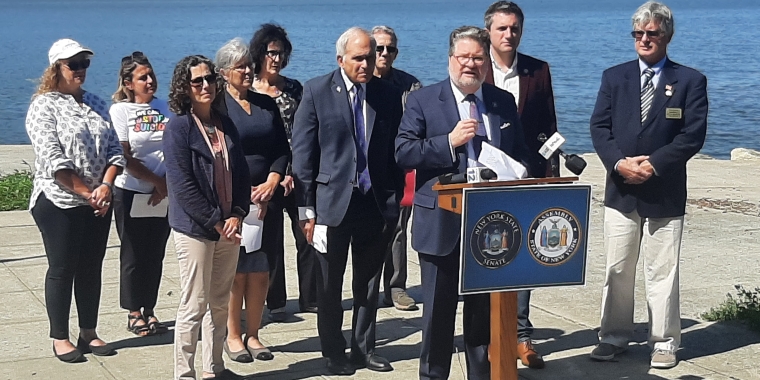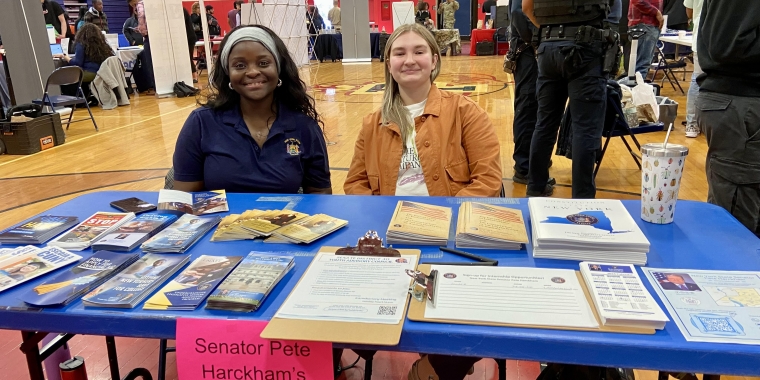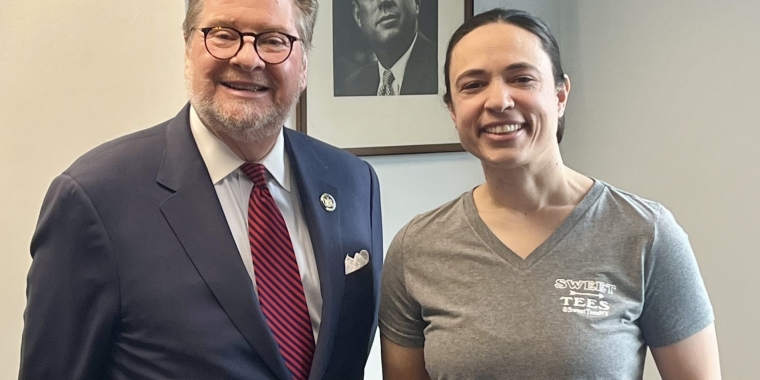
Harckham, Gunther, Hudson Valley Lawmakers and Suicide Prevention Advocates Renew Call for Restriction Fencing on Area Bridges
May 30, 2024

State Sen. Harckham speaking at a Sep. 2023 press conference calling for climb deterrent bridge fencing
Peekskill, NY – New York State Senator Pete Harckham and Assemblymember Aileen Gunther, along with several other Hudson Valley lawmakers, sent a letter to the New York State Bridge Authority (NYSBA) this week to express their concern over the lack of concrete steps taken to install proven suicide prevention measures, like climb deterrent fencing, on the five Mid-Hudson bridges under its jurisdiction.
(The NYSBA owns, operates and maintains five Hudson River crossings for vehicular traffic: Rip Van Winkle Bridge, Kingston-Rhinecliff Bridge, Mid-Hudson Bridge, Newburgh-Beacon Bridge and Bear Mountain Bridge.)
So far this month, there have been four suicide attempts on these bridges, with two known fatalities, alarming many New Yorkers and accentuating the need for preventative safety measures to be installed as soon as possible.
Harckham, Gunther and the lawmakers have been in dialogue with NYSBA about the need for climb deterrent fencing on the bridges for several years; they have introduced legislation and held two press conferences on the issue as well. Their growing frustration over NYSBA’s lack of action has led to this new letter, attached to this press release, in which the elected officials inform NYSBA that they will pursue a legislative solution to this longstanding safety issue if the authority fails to make a public commitment to addressing it.
“The four recent suicide attempts, two from the Bear Mountain Bridge, attest to a heartbreaking problem: it is time to erect means restriction or climb deterrent fencing on these five area bridges,” said Harckham. “Over the years, I have met grieving family members who want this fencing to be erected, and it is confounding that it has not been. We have given the New York State Bridge Authority ample opportunity to address this issue on its own, but we simply can’t wait any longer. These are preventable deaths—and more families should not have to grieve.”
“The time is now to take action to prevent these terrible tragedies,” said Gunther. “Barriers on bridges are proven to prevent suicides, and each day we wait could be another life lost. With the state of mental health in New York today, we must take every possible action to protect our friends and neighbors.”
Harckham and Gunther have introduced a bill (S.2708 / A.9248) that will mandate climb deterrent fencing be installed on all bridges under NYSBA’s jurisdiction. The bill is based on statistical research showing that bridge barriers are an effective deterrent against suicide attempts.
The five NYSBA bridges serve to connect communities and provide thoroughfare for commerce; however, they also provide lethal means for about 10 publicly reported suicides and attempts per year. Since at least 2007 NYSBA has been aware of the suicide problem on its bridges. In the 17 years that have elapsed from NYSBA’s original consultation with the National Suicide Prevention Lifeline, 103 completed suicides and 43 attempts (to date) have occurred impacted by the absence of reasonable suicide prevention.
Bridge fencing is a universal solution, passively engaging with those that don’t require it, and actively preventing those that do need it. The inhibits both suicide attempts and accidental falling deaths from the bridges. Countless studies have shown that bridge fencing works; it is unequivocally the most effective solution to bridge suicides.
Other public agencies have successfully reduced suicide attempts by deploying barriers. Notably, the Duke Ellington Bridge in Washington, DC, was the site of one-half of all bridge suicides in the city until fencing was installed. Suicide attempts at this bridge reduced dramatically, while suicide rates at the nearby Taft Bridge, which was non-barrier-restricted, remained unchanged.
And there has also been no evidence found that barriers on bridges lead to “method substitution” for would-be victims of suicide.
Senator Nathalia Fernandez said, “Given the alarming statistics on suicide rates, particularly among young Americans, it is imperative that we take decisive action to prevent these tragedies. This bill to mandate climb deterrent fencing on all bridges under the jurisdiction of the NYSBA is a crucial step towards achieving this goal. By installing these barriers, we not only enhance public safety but also offer individuals in crisis precious time for intervention and assistance. I thank my colleague Senator Harckham for introducing this legislation, as it underscores our commitment to saving lives and building a safer New York.”
Senator James Skoufis said, “Increasing the distance between thought and action can be a significant step in preventing suicide, and barriers such as fencing can give individuals contemplating suicide something they desperately need: time. Time to think, time to change their minds, time for someone to intervene, or time to seek help. Climb deterrent fencing prevents our bridges from becoming press magnets, and, more importantly, can save lives. This issue has been on the table for too long, but when lives are at stake, we shouldn’t wait another day.”
Assemblymember Christopher Eachus said, “The recent rise in suicides and injuries off our local bridges only highlights the critical need to pass this legislation. Installing climb deterrent fencing is a simple but effective way to significantly decrease suicide attempts through making it more difficult to do so, and hopefully lead individuals to overcome their mental crisis to get the services they need. I am proud to be a co-sponsor on this bill and will be fighting to ensure its passage. Lives are at stake, and every moment that passes gives chances for these tragedies to continue.”
Assemblymember Dana Levenberg said, “Safety measures like climb deterrent fencing must be part of New York State’s multifaceted approach to preventing suicide in our communities, and there is no time to waste. The recent rash of suicide attempts on our Hudson Valley bridges underscores the urgent need to address this issue. Physical barriers need to be erected along these bridges to give people more time to think about their actions and, hopefully, find the support they need to improve their mental health.”
Westchester County Legislator Erika Pierce said, “After a truly tragic weekend, we are again calling upon the Bridge Authority to protect our community members by installing suicide deterrent fencing on its bridges. The data is clear and simple: fencing saves lives. As someone who lost a family member on the Bear Mountain Bridge and as a legislator, I call upon New York State to invest in the health and wellbeing of our residents, because every day we delay, is a day where another team might be sent out to retrieve the bodies of our loved ones.”
Maria Idoni, Hudson Valley / Westchester director for the American Foundation for Suicide Prevention (AFSP), said, “AFSP recognizes that physical barriers are the most effective means of preventing suicides on bridges. Bridges and other publicly accessible areas of significant height pose a risk for suicide attempts. Barrier installation is a proven method of increasing this crucial time for individuals at risk for suicide by jumping. These barriers act as a delay or deterrent to an individual at risk, providing more time to get through the intense, often brief, moment of suicide crisis. We hope that NYSBA will start to look at each life lost to suicide on their bridge, as a life that could have been saved, if there were barriers."
Marie Considine, executive director of NAMI Westchester, said “The National Alliance on Mental Illness of Westchester County recognizes the lives lost on New York bridges and empathizes with those who have taken their lives and their families who lost their loved ones to suicide, as well as those first responders who are impacted by this trauma. New Yorkers need means restrictive barriers as well as permanent messaging on all bridges overseen by the New York State Bridge Authority (NYSBA), including the Walkway Over the Hudson in order to prevent further loss of lives, and we need the commitment of the NYS Bridge Authority to get the barriers and messaging funded and installed without further delay.”
Roy Ettere, a Somers resident, who lost a child to suicide, said, “We support the placement of bridge barriers at the Hudson River crossings. Too many lives have been lost over the years by suicides from these bridges. Saving one life is worth all the money spent to install the barriers. You just have to ask a suicide loss survivor. The statistics are alarming. We need to do all we can to stop this lethal means of access to suicide.”
Clare Redden, a suicide prevention advocate, said, “Witnessing a teenager jump 135 feet from the Newburgh-Beacon Bridge profoundly changed my life. He did not die on impact, and as the first to get to him, he kept repeating, ‘I don’t know what happened, I don’t know what happened; I think I jumped.’ A fence would have provided what he needed, time. That day and the years after for the boy, for me, and for all the first responders could have gone very differently, had there just been a fence.”



